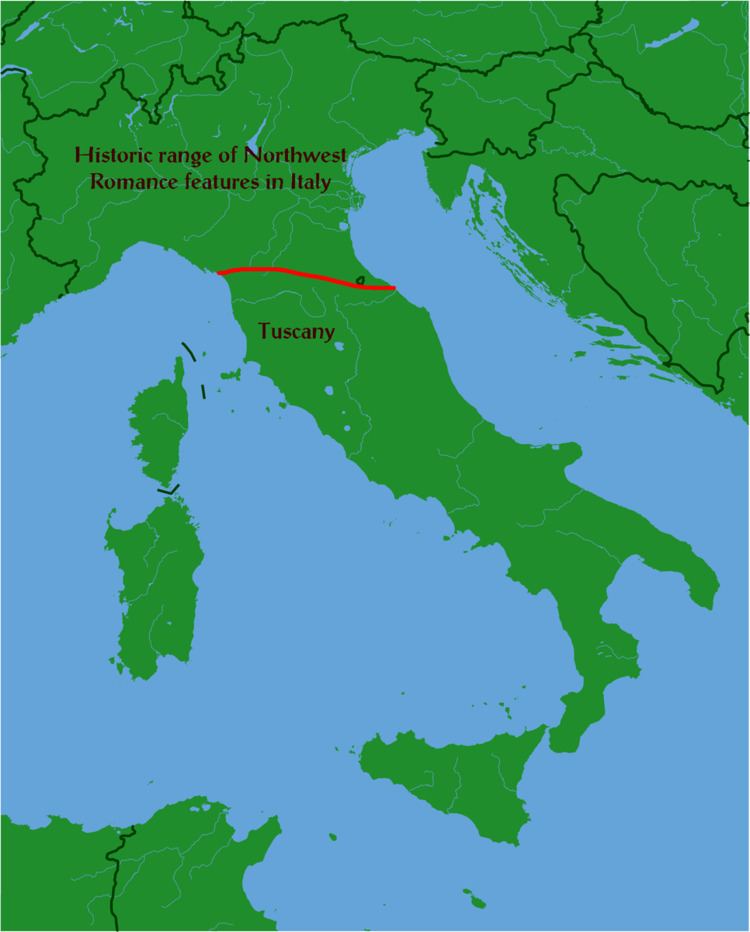 | ||
The La Spezia–Rimini Line (also known as the Massa–Senigallia Line), in the linguistics of the Romance languages, is a line that demarcates a number of important isoglosses that distinguish Romance languages south and east of the line from Romance languages north and west of it. The line runs through northern Italy, very roughly from the cities of La Spezia to Rimini. Romance languages on the eastern half of it include Italian and the Eastern Romance languages (Romanian, Aromanian, Megleno-Romanian, Istro-Romanian), whereas Spanish, French, Catalan, Portuguese as well as Gallo‒Italic languages are representatives of the Western group. (Sardinian does not fit into either Western or Eastern Romance.)
Contents
It has been suggested that the origin of these developments is to be found in the last decades of the Western Roman Empire and the Ostrogothic Kingdom (c. 395–535 AD). During this period, the area of Italy north of the line was dominated by an increasingly Germanic Roman army of (Northern) Italy, followed by the Ostrogoths; whereas the Roman Senate and Papacy became the dominant social elements south of the line. As for the provinces outside Italy, the social influences in Gaul and Iberia were broadly similar to those in Northern Italy, whereas the Balkans were dominated by the Byzantine Empire at this time (and later, by Slavic peoples).
Some linguists, however, say that the line actually runs through Massa and Senigallia about 40 kilometres further to the south and would more accurately be called the Massa–Senigallia Line.
Generally speaking, the western Romance languages show common innovations that the eastern Romance languages tend to lack. The two isoglosses generally considered are:
Plural of nouns
North and west of the line (excluding all Northern Italian varieties) the plural of nouns was drawn from the Latin accusative case, and is marked with /s/ regardless of grammatical gender or declension. South and east of the line, the plurals of nouns are marked by changing the final vowel, either because these were taken from the Latin nominative case, or because the original /s/ changed into a vocalic sound (see the Romance plurals debate). Compare the plurals of cognate nouns in Aromanian, Romanian, Italian, Spanish, Portuguese, Catalan, French, Sardinian and Latin:
Voicing of consonants
Another isogloss that falls on the La Spezia–Rimini Line deals with the restructured voicing of voiceless consonants, mainly Latin sounds /p/, /t/ and /k/, which occur between vowels. Thus, Latin catēna ('chain') becomes catena in Italian, but cadeia in Portuguese, cadena in Catalan and Spanish, cadéna/cadèina in Emilian, caéna in Venetian and chaîne in French. Voicing, or further weakening, even to loss of these consonants is characteristic of the western branch of Romance; their retention is characteristic of eastern Romance.
However, the differentiation is not systematic, and there are exceptions that undermine the isogloss: Gascon dialects in south-west France and Aragonese in northern Aragon, Spain (geographically Western Romance) also retain the original Latin voiceless stop between vowels.
Indeed, the significance of the La Spezia–Rimini Line is often challenged by specialists within both Italian dialectology and Romance dialectology. One reason is that while it demarcates preservation (and expansion) of phonemic geminate consonants (Central and Southern Italy) from their simplification (in Northern Italy, Gaul, and Iberia), the areas affected do not correspond consistently with those defined by voicing criteria. Romanian, which on the basis of lack of voicing is classified with Central and Southern Italian, has undergone simplification of geminates, a defining characteristic of Western Romance.
